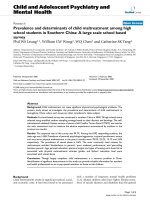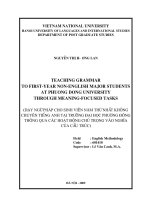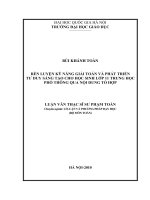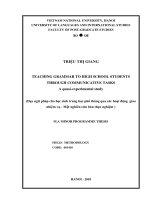Teaching grammar to High school students through communicative tasks a quasi-experimental study = Dạy ngữ pháp cho học sinh trung học phổ thông qua các hoạt độn
Bạn đang xem bản rút gọn của tài liệu. Xem và tải ngay bản đầy đủ của tài liệu tại đây (167.59 KB, 4 trang )
VIETNAM NATIONAL UNIVERSITY, HANOI
VIETNAM NATIONAL UNIVERSITY, HANOI
UNIVERSITY OF LANGUAGES AND INTERNATIONAL STUDIES
FACULTY OF POST-GRADUATE STUDIES
TRIỆU THỊ GIANG
TEACHING GRAMMAR TO HIGH SCHOOL STUDENTS
THROUGH COMMUNICATIVE TASKS
A quasi-experimental study
(Dạy ngữ pháp cho học sinh trung học phổ thông qua các hoạt động giao
nhiệm vụ - Một nghiên cứu bán thực nghiệm )
M.A MINOR PROGRAMME THESIS
FIELD: METHODOLOGY
CODE: 601410
HANOI - 2010
VIETNAM NATIONAL UNIVERSITY, HANOI
UNIVERSITY OF LANGUAGES AND INTERNATIONAL STUDIES
FACULTY OF POST-GRADUATE STUDIES
TRIỆU THỊ GIANG
TEACHING GRAMMAR TO HIGH SCHOOL STUDENTS
THROUGH COMMUNICATIVE TASKS
A quasi-experimental study
(Dạy ngữ pháp cho học sinh trung học phổ thông qua các hoạt động giao
nhiệm vụ - Một nghiên cứu bán thực nghiệm )
M.A MINOR PROGRAMME THESIS
FIELD: METHODOLOGY
CODE: 601410
SUPERVISOR: LÊ VĂN CANH, M.A
HANOI - 2010
MA Thesis
4
Table of contents
Page
Certificate of the study project report……………………………………………………i
Acknowledgements…………………………………………………………………… …ii
Abstracts……………………………………………………………………. ……………iii
Tables of contents……………………………………………………………………… iv
List of tables and figures………………………………………………………………….vi
List of abbreviation…………………………………………………………………… vii
CHAPTER 1: INTRODUCTIOn. ………………………………………………………1
1.1. Rationale ………………………………………………… …… 1
1.2. Aims of the study……………………………………………… …………………… 2
1.3. Research hypothesis and questions……………………………… 2
1.4. Research hypothesis and questions……………………………… 2
1.5. Significance of the study………………………………………….……………… 2
1.6. Scope of the study …………………………………………………………………….3
1.7. Organization of the study ………………………………………… 3
1.8. Summary……………………………………………………………………………….3
Chapter 2: Literature review…………… ………………… …… ……….4
2.1. The role of grammar in foreign language teaching and learning………………… 4
2.1.1. Arguments in favor of grammar teaching…………………………… …………… 4
2.1.2. Arguments against teaching grammar……………………………………………… 5
2.1.3. Grammar in communicative activities… 7
2.2. Approaches to grammar………………………………… ………………… 7
2.2.1. The deductive approach………………………………………………………………7
2.2.2. The inductive approach………………………………….…… ………… 8
2.2.3. Focus on form and focus on forms …………………………………………………10
2.3. Task-based language teaching……………………………… 12
2.3.1. What is TBLT?…………………………………………………………………… 12
2.3.2. Definition of task……………………………………… ………………………… 14
2.3.3. The basic characteristics of TBLT……………………………… 15
2.3.4. Studies on TBLT…………………………………………………………… 16
2.4. Task-based grammar teaching…………………………………………………… 18
2.4.1. Why task-based grammar teaching…………………………………………………18
MA Thesis
5
2.4.2. Steps in Task-based grammar teaching…………………………………………… 19
2.4.3. Characteristics of the Task-based Grammar Class …………… ………………… 20
2.4.4. Studies on task-based grammar teaching………………………….……………… 21
2.5. Summary…………………………………………………………………………… 22
Chapter 3: RESEARCH METHODOLOGY……………………………… …… 23
3.1. The syllabus of grade 10…………………………………………………………… 23
3.2. The subjects ………………………………………………………………………….24
3.3. Rationale for using quasi- experiment …………………………………………… 24
3.4. Research design……………………………………………… 25
3.5. Procedures………………… ………………………………….……………………27
3.6. The tasks…………………………………………….……………………………… 28
3.7. Findings……………………………………………………………………………….30
3.7.1. Comparison of the pretest and posttest scores, the gain value between the
two groups……… …………………………………………………………………31
3.7.2. The subjects' attitudes towards the new teaching method-teaching
grammar through communicative tasks…………………………………………… 32
3.8. Discussion.……………………………………………………………. …………… 35
3.8.1. The impact of the TBLT on grammar acquisition……………… 35
3.8.2. Students' attitudes towards teaching grammar through communicative tasks………36
3.9. Summary……………………………………………………… 36
Chapter 4: Recommendations and conclusions…………………… 38
4.1. Some recommendations……………………………………… 38
4.2. Limitations of the study…………………………………………………………… 38
4.3. Summary ……………………………………………… … ……………………… 39
References…………………………………………………………………………….40
Appendix 1. The Pretest……………………………………………………………………I
Appendix 2. The Posttest…………………………………………………………………III
Appendix 3. Post-questionnaire program for the experimental students…… …… V
Appendix 4. Tasks for teaching conditional sentence type 2…………………………. VI
Appendix 5. Tasks for teaching should or should not……………………………… VIII
Appendix 6. The results of the pretest and posttest of the two groups……………… X









